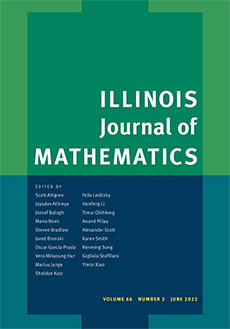Abstract
We consider two natural definitions for the notion of a dynamical system being mixing relative to an invariant sub $\sigma$-algebra $\mathcal{H}$. Both concern the convergence of
\[|E(f\cdot g\circ T^n|\mathcal H)-E(f|\mathcal H)E(g\circ T^n|\mathcal H)|\to 0\]
as $|n|\to \infty$ for appropriate $f$ and $g$. The weaker condition asks for convergence in $L^1$ and the stronger for convergence a.e. We will see that these are different conditions. Our goal is to show that both these notions are robust. As is quite standard we show that one need only consider $g=f$ and $E(f|\mathcal H)=0$, and in this case $|E(f\cdot f\circ T^n|\mathcal H)|\to 0$. We will see rather easily that for $L^1$ convergence it is enough to check an $L^2$-dense family. Our major result will be to show the same is true for pointwise convergence, making this a verifiable condition. As an application we will see that if $T$ is mixing then for any ergodic $S$, $S\times T$ is relatively mixing with respect to the first coordinate sub $\sigma$-algebra in the pointwise sense.
Citation
Daniel J. Rudolph. "Pointwise and $L\sp 1$ mixing relative to a sub-sigma algebra." Illinois J. Math. 48 (2) 505 - 517, Summer 2004. https://doi.org/10.1215/ijm/1258138395
Information





